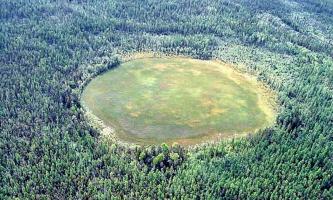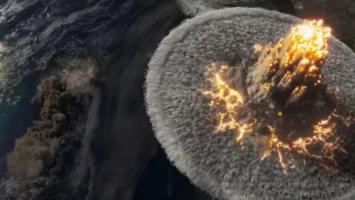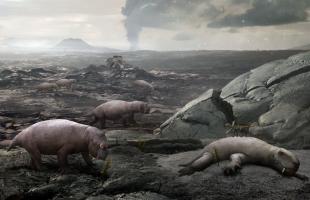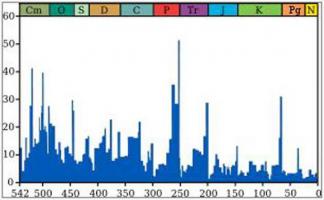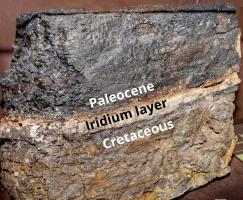Several hypotheses to explain the dinosaurs's extinction
Introduction
Since the first complex living beings appeared on our planet, life has experienced several biological crises, in particular the more or less sudden disappearance of entire animal and plant species.
The most famous of these crises occurred about 65 million years ago at the end of the geological period called the Cretaceous period when about 80 percent of the animal and plant life on Earth disappeared; species that became extinct during this period include ammonites (marine organisms endowed with a magnificent spirally coiled shell) and the very famous dinosaurs.
This crisis was not the only nor the most catastrophic one; scientists have discovered traces of several 'great extinctions' while the most terrible one occurred about 250 million years ago, at the end of the geological period called the Permian, when 90 percent (and perhaps more) of all living species disappeared and life was in serious danger of disappearing forever.
In the following texts we will go into more detail about the characteristics of these major extinctions and try to explain their possible causes.
Meteorite
65 Millions of years ago, a meteorite hit the earth's surface destroying 80 percent of the living species. Many paleontologists seem to have found confirmation of this meteorite in the rocks of British Columbia, a province of Canada at the Pacific coast. Here they found a carbon molecule with a soccer ball's shape, called Buckyballs. These discoveries were also found in Yucatan, Mexico, in rock layers 65 million years old.
Volcanic Eruptions
Earth, a land without peace. By looking at the appearance of our planet over geological eras it is evident that major physical changes have occurred, altering the contours and topography of the continents. The primary cause of these physical changes can be traced back to plate tectonics, in particular the movement of the oceanic plates and the continental masses.
Continents have undergone changes in shape and position since they were formed as parts of the cold outer crust of a planet still in a liquid state. The outer crust is fragmented into vast portions, called plates or clods. Eight major clods and a number of minor clods have been identified, all moving, pushed, pulled or compressed by convection currents in the molten environment below. Occasional collisions of the clods cause spectacular topographic changes such as the formation of mountain ranges, although it is often difficult to adequately assess their extent at first glance. The displacement of a sod can result in different events. For example, one sod moving away from another will literally tend to tear the Earth's crust apart, allowing new molten magma to fill the voids and form a mountainous submarine ridge composed of new crust. Continuously separating at these rifting and plate margin points, the continents move away from their original position. The space they leave behind is filled by oceanic waters.
The collision between oceanic clods and continental clods cause changes in the shape of the continents. Because the continental clods are lighter, the dense and heavy oceanic clods are pushed down toward the molten core of the Earth in a process called subduction. The result is not only the destruction of the oceanic crust, but also the possible deformation of the continental plate, resulting in the formation of mountain ranges along the margins of the continent. In the course of mountain range formation, intense volcanic activity may also occur.
Even larger mountains can form when two continental plates come to collision, and the two continents are pushed against each other. Along the collision line, the continental margins are folded upward and pushed to dizzying heights, forming immense mountain ranges. Sometimes the continents collide at a less direct angle of impact and slide past each other. In such cases, rather than the uplift of mountain ranges or the destruction of clods, earthquakes can occur if the continent's fractures, or faults, slip to discharge the accumulated friction from the movement of clods. Forces circulating in the molten interior of the Earth can produce particular hot spots that, as they cross the plates, erupt in the form of mountainous volcanoes. Thus, as a plate moves over a hot spot, a series of volcanic mountains can form. If these mounds become large enough, a chain of volcanic islands forms in the ocean. All the changes caused by the mechanism of plate tectonics change the position and shape of the continents and the oceans around them and affect the Earth's climate on a global scale. In turn, climate changes alter ecosystems. The biosphere then responds to environmental changes either by further adaptation or selective reshuffling: extinction.
Supernovae
Ancient chronicles tell us that in the year 1006 A.D. a new and very bright star appeared in the southern constellation of Wolf; the new star, in its moment of maximum splendor, reached and exceeded the brightness of the planet Venus after which it began to fade until it disappeared altogether after some time without a trace.
A similar phenomenon occurred 48 years later in the constellation of Taurus and attracted the attention of ancient Chinese astronomers while two others that occurred in 1572 in the constellation Cassiopeia and in 1604 in the constellation Ophiuchus were observed by the great Danish astronomer Thyco Brahe and his German student Johannes Kepler, respectively.
The mystery associated with these sudden star appearances was finally unraveled in the 1930s when the first theories of stellar evolution began to develop. According to these theories, when a very massive star exhausts its nuclear fuel in its interior very strong instabilities are established that degenerate into an apocalyptic explosion and the star self-destructs. The phenomenon is truly impressive: in the brief moments of the explosion the star releases as much energy as it had released in its entire life and becomes brighter than the entire galaxy containing it, that is, brighter than hundreds of billions of stars. These stellar explosions were called supernovae.
Supernovae are fairly rare phenomena, at least within the single galaxy; however, since there are billions of galaxies, supernovae explosions are continually observed in outer galaxies.
Their danger lies in the devastating fury of the explosion and the very large amount of X-rays and Gamma rays emitted. Let us remember that these radiations, in massive doses, are extremely dangerous to living organisms; consequently, if a supernova were to explode within a few hundred light-years of Earth, life would be severely damaged.
Gamma Ray Burst (gamma ray flashes)
During the 1960s some military satellites (Vela) set up to monitor compliance with treaties against the proliferation of nuclear weapons discovered the existence of real gamma ray bursts from space at the average rate of one flash per day. These phenomena were called GRBs, gamma ray bursts, and their origin remained a mystery. Recently, mainly thanks to the Italian satellite Beppo SAX, scientists have discovered that GRBs are due to titanic explosions, much more powerful than supernova explosions, occurring in very distant galaxies. The origin of these explosions, however, is still unclear; they are said to be either much more powerful supernovae than ordinary ones (hypernovae) or the merger of two neutron stars or a neutron star with a black hole.
What is very clear, however, is that GRBs are the most energetic and violent phenomena in the entire known universe; on December 14, 1997, Beppo SAX recorded the appearance of a gamma-ray burst whose power was second only to that of the Big Bang (which is why the gamma-ray burst in question was called 'the second Big Bang').
Asteroidal impacts
Phenomena of unprecedented violence (albeit many orders of magnitude less than that of a supernova or GRB) also occur within our solar system, and one need only observe the Moon with a modest telescope to realize this. The surface of our satellite appears dotted with craters due to impacts with minor bodies in the solar system; craters are widespread on all rocky Earth-type planets and on the satellites of Jovian planets.
In fact, the solar system, in addition to planets, contains millions of minor bodies (meteorites, asteroids, comets) ranging in size from a few thousandths of a millimeter to a few hundred kilometers; when the orbit of one of these bodies intersects that of a planet, a collision is possible.
The Earth in the past must also have been subjected to numerous impacts but the action of atmospheric agents (wind and rain) has almost totally obliterated its craters; nevertheless, some of these ancient scars are still visible such as, for example, the very famous crater, visible only from images taken at high altitude, located in the Canadian state of Quebec and generated by the impact of an asteroid that occurred about 200 million years ago.
The consequences of such impacts are devastating; in addition to immediate effects such as shock waves and giant tsunamis that would circle the planet several times, we would have long-term effects on the climate. In fact, the impact with a large asteroid or comet would cause the uplift of millions of tons of dust that would end up in the upper atmosphere, substantially reducing the amount of light coming from the Sun; thus, we would have an initial period of cooling and a drastic decrease in photosynthetic activity of plants that would be followed by a period of strong greenhouse warming.
For an ecosystem such as ours that depends heavily on temperature and almost entirely on sunlight, the consequences would be catastrophic with the disappearance of entire animal and plant species.
These astronomical considerations are almost prophetic. In fact, scientists studying the history of life on Earth have found, quite independently, that since the appearance of the first complex living organisms (about 700 million years ago) life has experienced and overcome several biological crises, i.e., the disappearance at more or less rapid times of very large numbers of species of living things that have been called 'great extinctions'.









